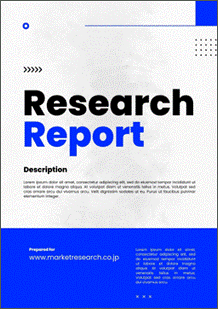 | • レポートコード:MRC2202A044 • 出版社/出版日:Mordor Intelligence / 2022年1月28日 • レポート形態:英文、PDF、100ページ • 納品方法:Eメール(受注後2-3営業日) • 産業分類:物流 |
| Single User | ¥703,000 (USD4,750) | ▷ お問い合わせ |
| Team User | ¥962,000 (USD6,500) | ▷ お問い合わせ |
| Corporate License | ¥1,295,000 (USD8,750) | ▷ お問い合わせ |
• お支払方法:銀行振込(納品後、ご請求書送付)
レポート概要
| Mordor Intelligence社は、世界の製薬物流市場規模が2019年から2024年の間に年平均4.1%成長すると予想しています。本書では、製薬物流の世界市場について調査し、イントロダクション、調査手法、エグゼクティブサマリー、政府規制/戦略、市場動向、輸送別(空気、トラック輸送、海上)分析、運用別(コールドチェーン、非コールドチェーン)分析、地域別(北米、ヨーロッパ、アジア太平洋、中南米、その他)分析、競争状況、市場機会/将来の見通しなどを掲載しています。 ・イントロダクション ・調査手法 ・エグゼクティブサマリー ・政府規制/戦略 ・市場動向 ・世界の製薬物流市場規模:輸送別(空気、トラック輸送、海上) ・世界の製薬物流市場規模:運用別(コールドチェーン、非コールドチェーン) ・世界の製薬物流市場規模:地域別(北米、ヨーロッパ、アジア太平洋、中南米、その他) ・競争状況(Deutsche Post DHL、Kuehne + Nagel、UPS (Marken)、DB Group、FedEx、Nippon Express、World Courier、SF Express、Panalpina、CEVA Agility、DSV、Kerry Logistics、CH Robinson、Air Canada Cargo、Americold Logistics、Lineage Logistics、United States Cold Storage、AGRO Merchants Group, LLC、Nichirei Logistics Group, Inc.、Kloosterboer、NewCold Advanced Cold Logistics、VersaCold Logistics Services、Cloverleaf Cold Storage Co.) ・市場機会/将来の見通し |
The Global Pharmaceutical Logistics Market is expected to grow at a Cagr of 4.1% in the forecast period of 2019-2024. The market growth is attributed to the increasing demand for the household healthcare products and raising importance of fast track assistance. Additionally, there is a growing need for maintaining the cold chain integrity for pharmaceutical products and decreasing the distribution cost by creating a single source distribution channel is further boosting the demand of pharmaceutical logistics. Research suggests that logistics costs comprises of about 45-55% of the costs in the Indian Pharmaceutical supply chain from factory to shelf. Logistics has long been considered as a basic supporting function within the life sciences sector.
The importance of logistics is growing for a number of reasons as listed below:
(1) The rising relevance of the emerging markets and globalization of supply chains
(2) Increased regulatory efforts specifically around the temperature management
(3) A changing product portfolio that, on the one hand, allows new direct-to-market approaches notably for specialties and, on the other hand, necessitates differentiated ‘value-focused’ approaches for value products and generics, where the cost of logistics drives a larger share of total cost.
Other key factors that are driving the logistics market in the life sciences industry are:
Expansion of many pharmaceutical and medical device manufacturers to tier 2 and tier 3 cities and also to certain rural areas in emerging countries.
Key Market Trends
Non cold chain product sales exceed cold chain products in Pharmaceutical industry globally
Non cold chain products exhibit higher sales over cold chain products in general all over the world. The non-cold chain spending is expected to grow at a cagr of ~2% from 2016 to 2022. A nominal increase in the cold-chain products is also expected due to the ongoing transition to bio-based products, rigorous preconditions of life science shipments coupled with the growing globalization of the pharmaceutical trade.
Cold-chain products require colder temperatures throughout the storage, handling, and transportation processes to maintain product integrity. Biopharma products are manufactured or extracted from various biological sources such as vaccines, blood and its components, as well as gene therapies.
US is the largest exporter of Pharmaceutical products by air transport
During the period of 2000-2016, the global pharmaceutical air trade has more than doubled. The demand for pharmaceutical logistics is growing in U.S. on account of the increasing sales of generic drugs, as well as reforms in the healthcare sector favoring generics. The market in the North America region is significantly fragmented owing to the presence of a large number of regional and international companies.
Competitive Landscape
The market is highly competitive with many companies striving to offer cloud-based supply chain solutions and a secured supply chain functions. These kind of technological implementation help manufacturers in verifying the authenticity of the drugs, thus avoiding the production of counterfeit drugs and medical devices. Numerous companies are entering into merger and acquisition to expand their geographical presence and their proprietary knowledge. They are also focusing on reducing the overall packaging costs of their products. In addition, economic reforms have led to the growth of the global market.
Additional Benefits:
- The market estimate (ME) sheet in Excel format
- 3 months of analyst support
1 INTRODUCTION
1.1 Scope of the Study
1.2 Key Deliverables of the Study
1.3 Study Assumptions
2 RESEARCH METHODOLOGY
2.1 Analysis Methodology
2.2 Research Phases
3 EXECUTIVE SUMMARY
4 GOVERNMENT REGULATIONS AND INITIATIVES
5 MARKET DYNAMICS
5.1 Current Market Scenario
5.2 Market Dynamics
5.2.1 Drivers
5.2.2 Restraints
5.2.3 Opportunities
5.3 Industry Attractiveness – Porter’s Five Forces Analysis
5.4 Value Chain/ Supply Chain Analysis
6 MARKET SEGMENTATION
6.1 By Mode of Transport
6.1.1 Air
6.1.2 Trucking
6.1.3 Ocean
6.2 By type of operation
6.2.1 Cold chain
6.2.1.1 Transport
6.2.1.2 Packaging
6.2.2 Non cold chain
6.2.2.1 Transport
6.2.2.2 Packaging
6.3 Geography
6.3.1 North America
6.3.1.1 United States
6.3.1.2 Canada
6.3.2 Europe
6.3.2.1 United Kingdom
6.3.2.2 Germany
6.3.2.3 France
6.3.2.4 Italy
6.3.2.5 Spain
6.3.3 Asia Pacific
6.3.3.1 China
6.3.3.2 India
6.3.3.3 Japan
6.3.3.4 South Korea
6.3.3.5 Singapore
6.3.3.6 Indonesia
6.3.3.7 Vietnam
6.3.3.8 Malaysia
6.3.3.9 Thailand
6.3.4 Latin America
6.3.4.1 Brazil
6.3.4.2 Argentina
6.3.5 Rest of the World
6.4 By Drug Supply stage
6.4.1 Outsourced
6.4.2 In-house
7 COMPETITIVE LANDSCAPE
7.1 Overview (Market Concentration and Major Players)
7.2 Company Profiles
7.2.1 Deutsche Post DHL
7.2.2 Kuehne + Nagel
7.2.3 UPS (Marken)
7.2.4 DB Group
7.2.5 FedEx
7.2.6 Nippon Express
7.2.7 World Courier
7.2.8 SF Express
7.2.9 Panalpina
7.2.10 CEVA
7.2.11 Agility
7.2.12 DSV
7.2.13 Kerry Logistics
7.2.14 CH Robinson
7.2.15 Air Canada Cargo
7.2.16 Americold Logistics
7.2.17 Lineage Logistics
7.2.18 United States Cold Storage
7.2.19 AGRO Merchants Group, LLC
7.2.20 Nichirei Logistics Group, Inc.
7.2.21 Kloosterboer
7.2.22 NewCold Advanced Cold Logistics
7.2.23 VersaCold Logistics Services
7.2.24 Cloverleaf Cold Storage Co.
8 MARKET OPPORTUNITIES AND FUTURE TRENDS
9 APPENDIX
10 DISCLAIMER AND ABOUT US